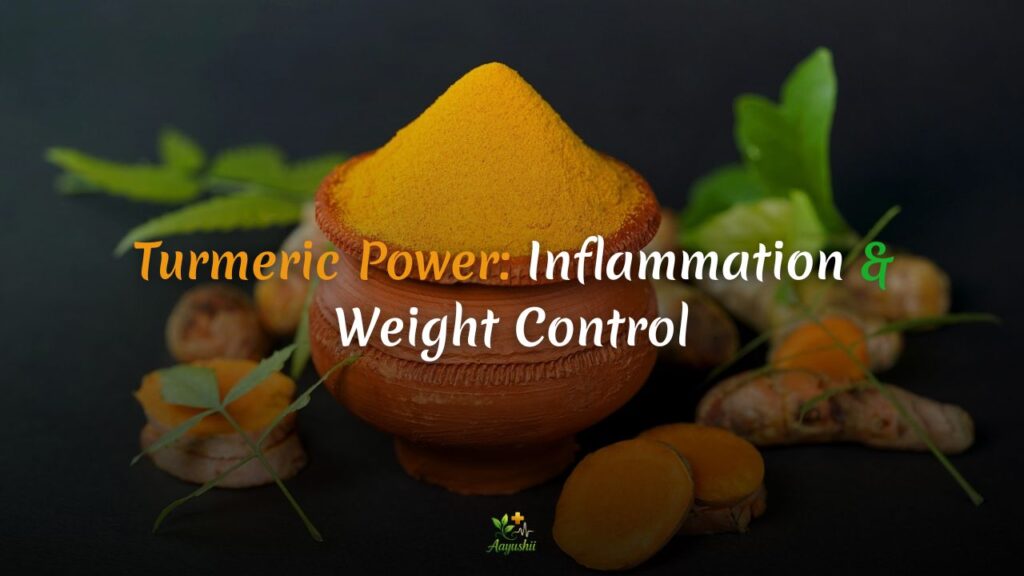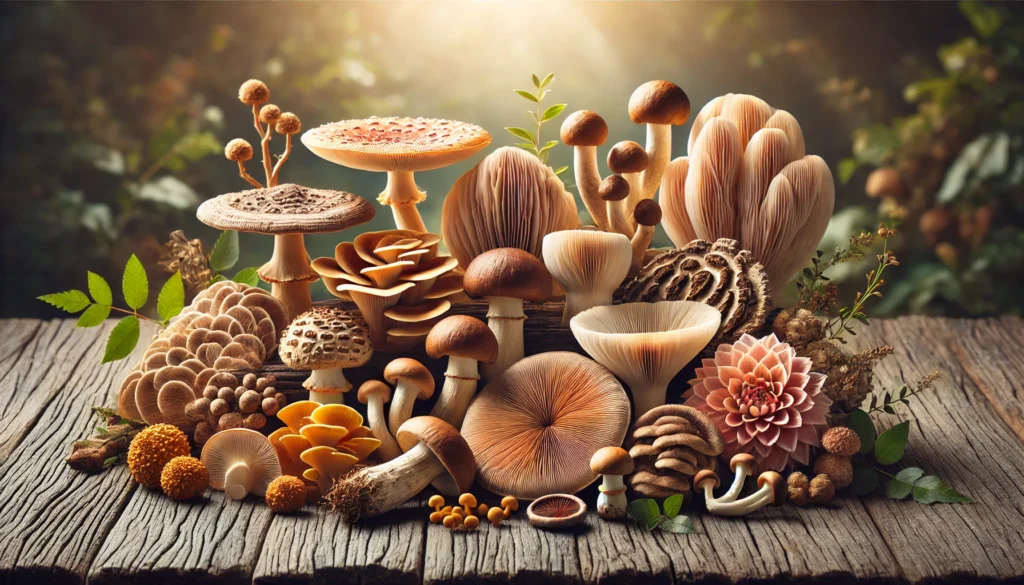Walk into any spice market in Colombo, an organic store in Brooklyn, or a fitness-influencer’s kitchen in Berlin and you’ll see the same flash of bright yellow—turmeric. Long before hashtags like #AntiInflammatory or #WeightLossGoals existed, Ayurvedic physicians were grinding this rhizome into tonics to soothe swollen joints and “cool” fiery digestion. Modern biochemistry finally explains why those traditional formulas worked: curcumin, turmeric’s main polyphenol, down-regulates the same molecular fire-alarms that drive chronic inflammation and metabolic dysfunction.
But does sprinkling turmeric on rice really translate into lower C-reactive protein, smaller waistlines, and less knee pain? This deep dive answers precisely that. We will unpack:
- how systemic inflammation sabotages weight-control efforts;
- the exact mechanisms by which curcumin turns those flames down;
- what high-quality human trials say about fat-loss and metabolic markers;
- simple kitchen and supplement strategies to overcome curcumin’s infamous “poor absorption” problem;
- evidence-based dosages and safety considerations.
By the end, you’ll know how to use one humble spice as a potent, research-backed ally in your anti-inflammatory and weight-management routine.
Table of Contents
The Inflammation–Weight-Gain Loop
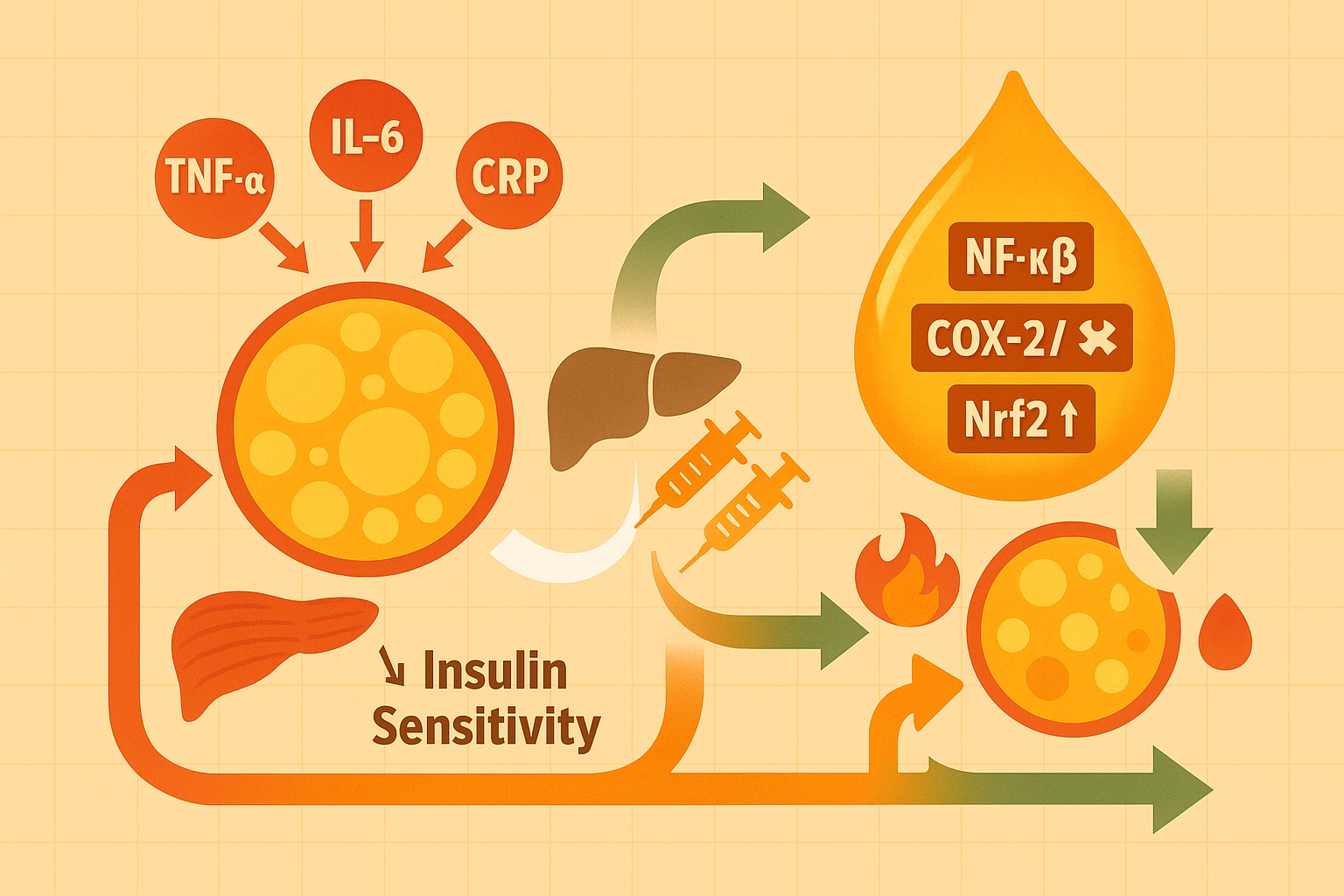
Low-grade systemic inflammation is not just a symptom of obesity—it is a key driver. Adipose tissue overloaded with triglycerides pumps out pro-inflammatory cytokines (TNF-α, IL-6, CRP). Those messengers decrease insulin sensitivity in muscle and liver, forcing the pancreas to secrete more insulin, which in turn locks fat into storage mode. Round and round it goes: more fat → more inflammation → harder fat-loss. Breaking that loop requires dialing down inflammatory signaling while restoring metabolic flexibility.
Why Turmeric Matters Here
Curcumin has been shown to:
- inhibit the NF-κB transcription factor that coordinates many inflammatory genes;
- blunt COX-2 and LOX enzymes that create pain-promoting eicosanoids;
- up-regulate Nrf2, the “master switch” for antioxidant defenses.
When those pathways calm down, insulin receptors respond better, adipocytes burn rather than hoard fat, and mitochondrial engines run cleaner. (PubMed, ScienceDirect)
Turmeric vs Curcumin – Clearing Up

Turmeric = the whole root.
When you buy a pouch of bright‑yellow powder, you’re getting the dried rhizome of Curcuma longa ground—aromas, fibers, minerals, and more than 200 distinct phytochemicals. Only 3–5 % of that powder is the curcuminoid family, which itself is a trio: curcumin (~77 %), demethoxy‑curcumin (~17 %), and bis‑demethoxy‑curcumin (~3 %). The rest includes turmeric‑essential oils—mainly α‑ and ar‑turmerones—plus water‑soluble polysaccharides that have prebiotic and immune‑modulating effects. (Oxford Academic, Health)
Curcumin = the flagship molecule.
Curcumin’s diarylheptanoid backbone gives turmeric its color and—because it can slip inside cell membranes—lets it interact directly with enzymes like NF‑κB and COX‑2. Most clinical trials therefore isolate and standardize the curcuminoid fraction to ≥ 95 % curcuminoids so that every capsule delivers the same pharmacologic punch and results can be compared across studies. (Codeage, ScienceDirect)
Why whole‑food turmeric is still special. The essential‑oil layer isn’t just fragrant; turmerones have been shown to increase intestinal absorption of curcumin and add their own anti‑inflammatory and neuro‑regenerative activity. In several cell and animal models, curcumin + turmerones outperformed curcumin alone. (PMC, ScienceDirect)
So which should you take?
- Culinary turmeric gives broad‑spectrum synergy but requires heaping teaspoons to match the curcumin dose used in arthritis or metabolic‑syndrome trials.
- Standardized extracts (often paired with black‑pepper piperine or formulated as micelles) guarantee a repeatable, research‑level curcumin payload—crucial if you’re targeting measurable drops in CRP, fasting insulin, or joint‑pain scores.
For everyday wellness, flavor your food with turmeric and pepper; for therapeutic aims, consider an evidence‑based extract—and remember that both approaches stem from the same golden root. (verywellhealth.com)
How Curcumin Quenches the Inflammatory Fire
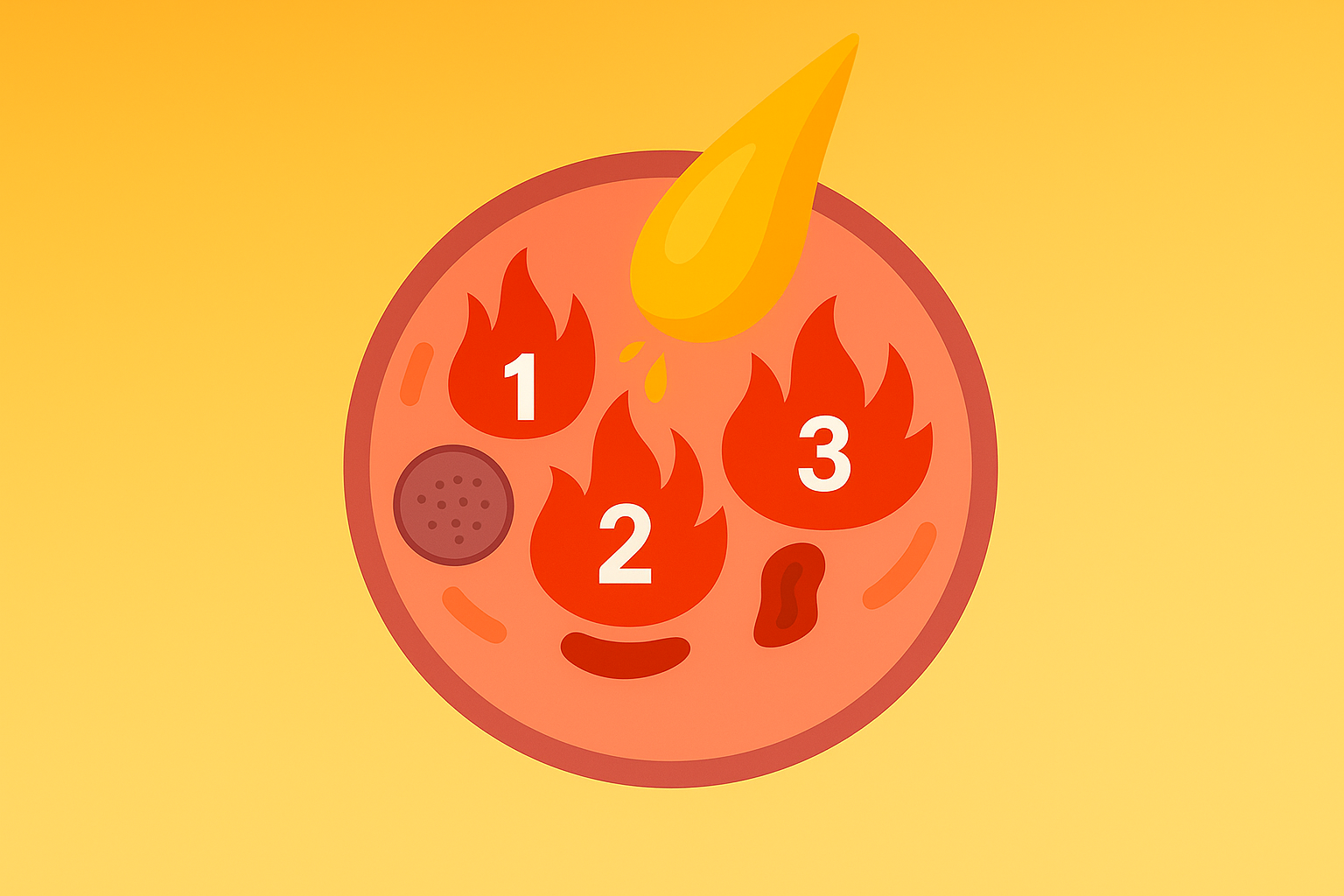
Turning Down NF-κB
NF-κB is the “central switchboard” that tells DNA to crank out cytokines like IL-1β and TNF-α. Curcumin binds to IKKβ (the enzyme that activates NF-κB), preventing its phosphorylation cascade. Less NF-κB activation means fewer inflammatory genes turned on. (PubMed)
Blocking COX-2 and LOX Without NSAID Risks
Non-steroidal anti-inflammatories (NSAIDs) block COX-2 but often irritate the gut lining. Curcumin down-regulates both COX-2 and 5-LOX enzyme expression while simultaneously thickening the gastric mucosa—one reason traditional turmeric “milk” often eases ulcers in Ayurveda.
Activating Nrf2 Antioxidant Pathways
Oxidative stress fuels chronic inflammation. Curcumin modifies Keap1 cysteine residues, freeing Nrf2 to enter the nucleus and turn on genes for glutathione, superoxide dismutase, and catalase. Your cells’ cleanup crew gears up, mopping free radicals before they trigger inflammatory signaling.
Improving Gut Barrier Integrity
Chronic inflammation often starts with “leaky gut.” Curcumin up-regulates tight-junction proteins (occludin, claudin-3), reducing endotoxin (LPS) leakage that can ignite systemic inflammation.
Curcumin and Weight Control – What the Science Shows
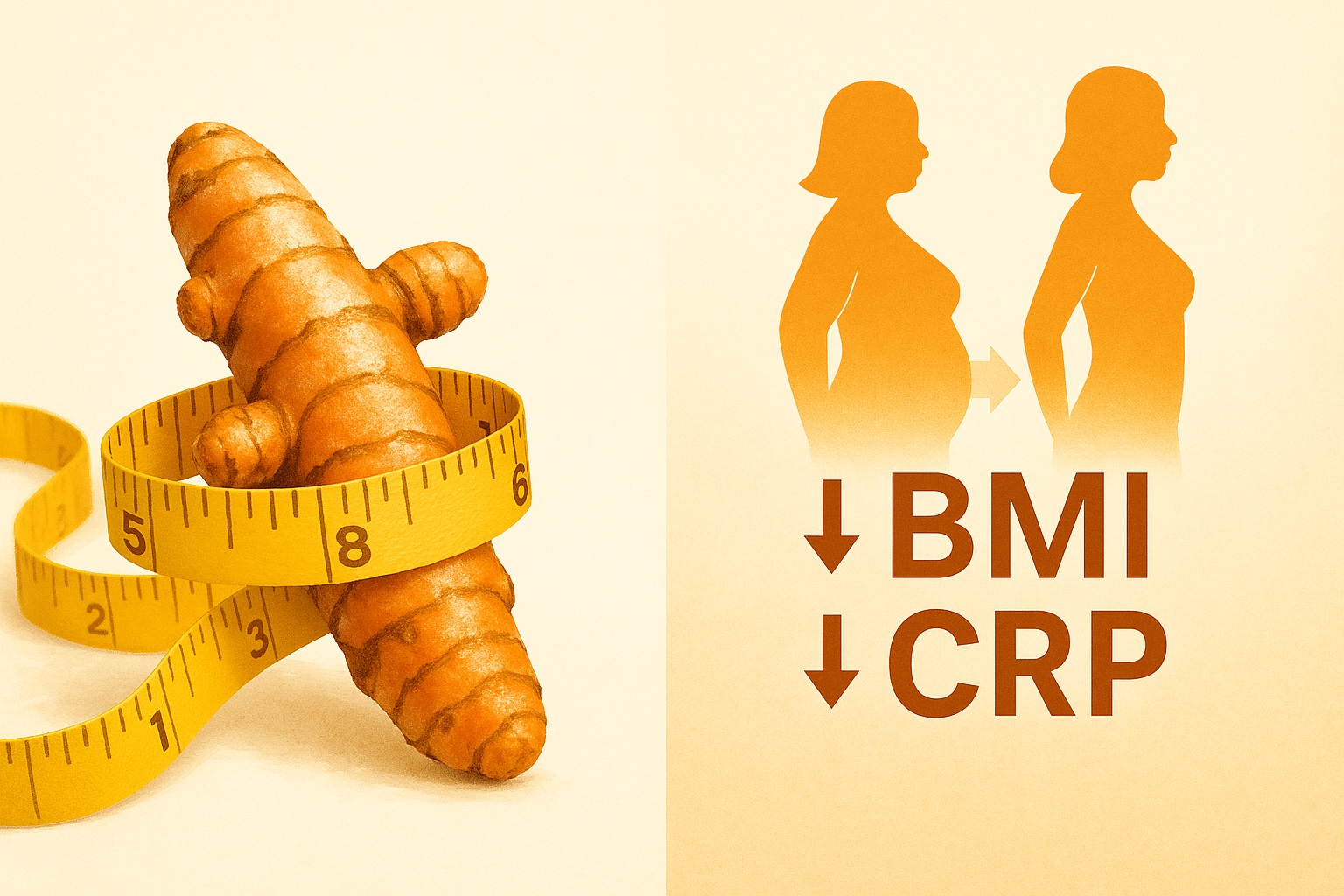
Anthropometric Outcomes
A 2023 umbrella meta-analysis pooling 2,248 participants found curcumin supplementation cut body-weight by an average 1.5 kg and BMI by 0.7 kg/m² over 8–12 weeks. (PubMed)
Sub-analyses revealed:
- Polycystic Ovary Syndrome (PCOS): –0.74 kg/m² BMI reduction. (ScienceDirect)
- Non-Alcoholic Fatty Liver Disease (NAFLD): Visceral fat decreased, liver enzymes improved.
- Obesity/Metabolic Syndrome: Waist-to-hip ratio fell alongside CRP and fasting insulin. (PubMed)
Mechanistic Drivers of Fat Loss
- Enhanced Insulin Sensitivity – Lower TNF-α reduces serine phosphorylation of insulin-receptor substrate-1, improving glucose uptake.
- AMPK Activation – Cellular studies show curcumin activates the AMPK “energy sensor,” nudging cells to burn rather than store fatty acids.
- Adipogenesis Inhibition – Curcumin down-regulates PPAR-γ and C/EBPα, key transcription factors that turn precursor cells into fat cells.
- Thermogenesis Support – In rodents, curcumin boosts UCP1 in brown adipose tissue; early human data hint at increased energy expenditure.
Appetite & Mood Modulation
Curcumin elevates BDNF and serotonin in animal models, potentially curbing “inflammation-driven” comfort-eating cycles. Human trials measuring satiety hormones are ongoing, but many participants report easier caloric control when systemic inflammation drops.
The Bioavailability Puzzle (and How to Solve It)

Curcumin is lipophilic and quickly conjugated in the liver, so raw turmeric powder floods your curry with flavor but only trickles into your bloodstream. Solutions:
- Black Pepper Synergy – Piperine inhibits hepatic glucuronidation, boosting curcumin absorption up to 2,000 %. Sprinkle freshly ground pepper into any turmeric recipe or choose supplements that include it. (PubMed Central, EatingWell)
- Nano- and Liposomal Formulations cloak curcumin in phospholipids or micelles, smuggling it through intestinal membranes. Some have 5–10× the plasma AUC of plain powder. (PubMed Central)
- Heat + Oil – Light simmering in ghee or coconut oil helps curcumin dissolve and pass the gut wall. This echoes traditional “tempering” (tadka) methods that Ayurveda codified centuries ago.
- Whole-Root + Essential Oils – Turmerones in the rhizome’s oil fraction improve curcumin uptake; look for CO₂-extracted “full-spectrum” tinctures if you prefer minimally processed options.
Ways to Put Turmeric to Work

Culinary Staples
- Golden Milk Before Bed – Warm 250 ml almond or coconut milk with ½ tsp turmeric, pinch of black pepper, and ¼ tsp cinnamon. The fat phase plus piperine increases uptake while cinnamon provides additional metabolic support.
- Inflammation-Fighting Smoothie – 1 cup pineapple (bromelain), 1 cup spinach, knob of fresh turmeric root, ½ tsp grated ginger, black pepper, and a teaspoon chia seeds for omega-3 synergy.
- Savory Roasted Veggies – Toss cauliflower florets with turmeric, cumin, olive oil, and pepper. Roast at 200 °C for 25 minutes.
Supplement Blueprint
| Goal (adult) | Typical Standardized Dose* | Timing |
|---|---|---|
| General anti-inflammatory maintenance | 500 mg curcuminoids with 5 mg piperine | With a fat-containing meal |
| Weight-loss intervention (clinical trial range) | 1 – 1.5 g curcuminoids daily, divided | Breakfast & dinner |
| Joint-pain flare | Up to 2 g/day for 8–12 weeks | Under professional supervision |
*Check your specific extract’s curcuminoid percentage; “800 mg turmeric” is not the same as “800 mg curcuminoids.”
Safety, Side-Effects, and Interactions
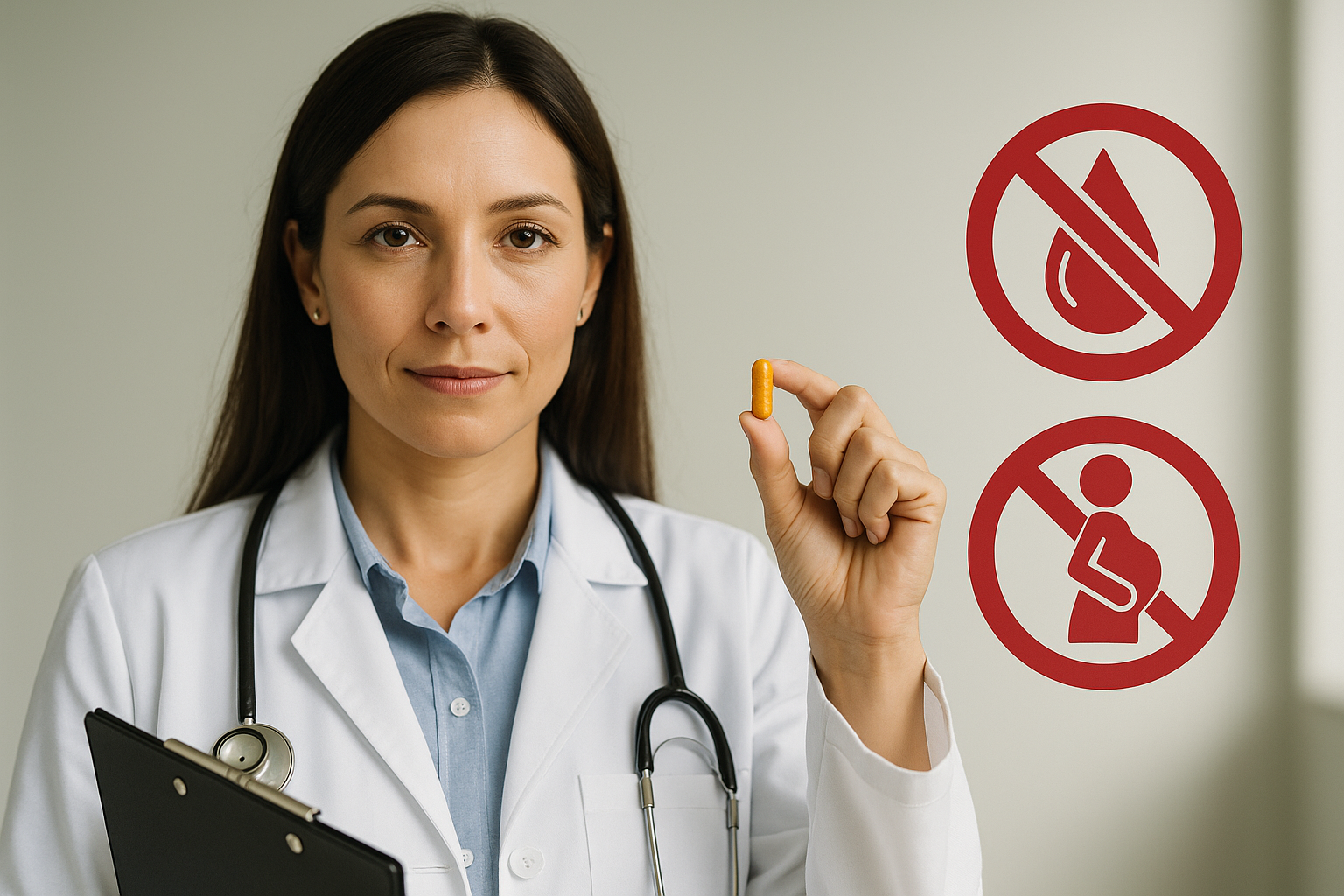
Regulatory agencies set turmeric’s Acceptable Daily Intake around 3 mg/kg body-weight for curcumin equivalents (≈ 210 mg for a 70 kg adult). (Committee on Toxicity, European Food Safety Authority) Human trials routinely use 500 mg – 3 g daily for up to six months with few adverse events, but caution is warranted if you:
- take anticoagulants (curcumin is mildly anti-platelet);
- have gallstones or bile-duct obstruction (it stimulates bile flow);
- are pregnant—high supplemental doses lack robust safety data.
Always start low, track digestion, and consult a healthcare provider if you’re on critical medications.
Choosing a Quality Product (If You Supplement)
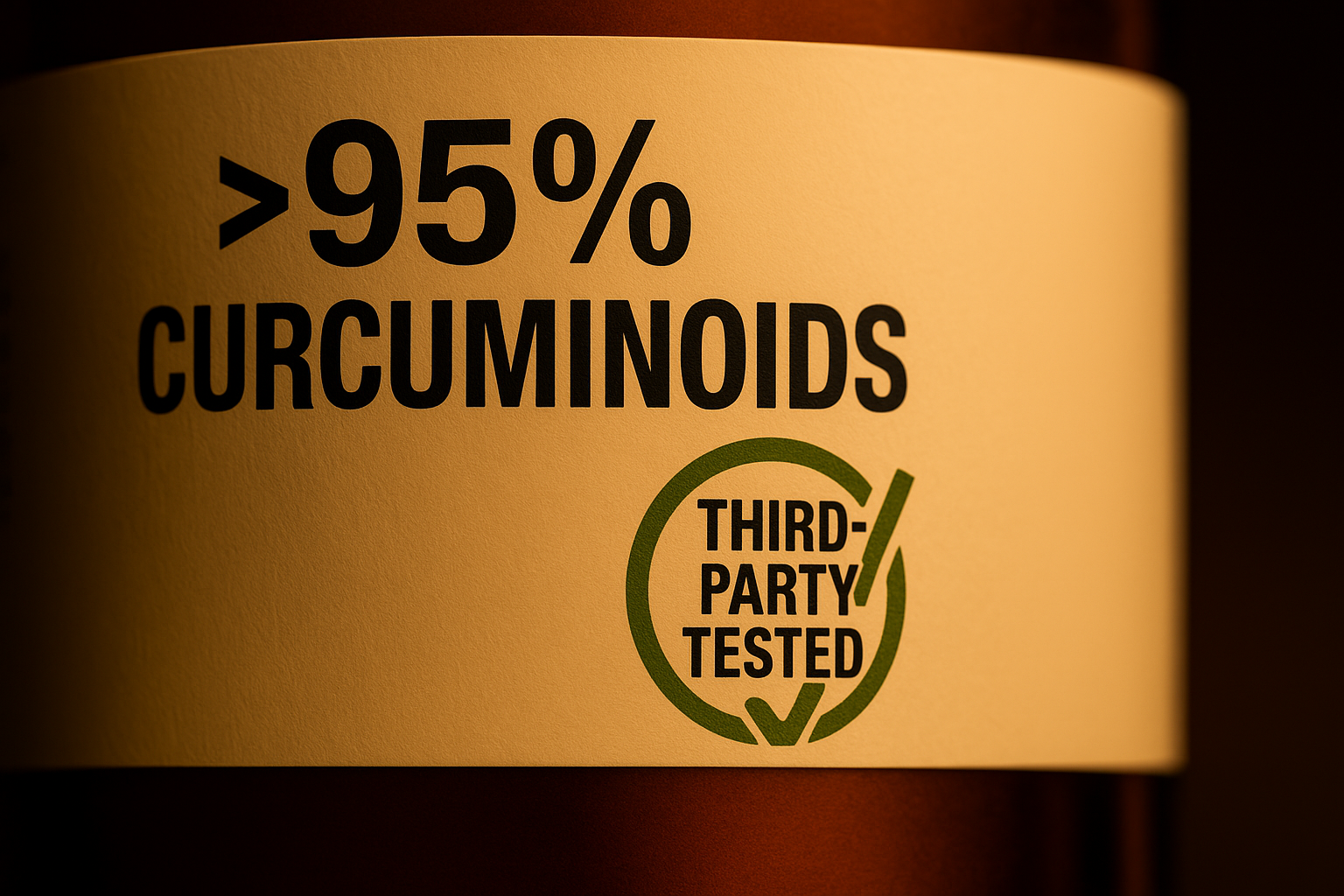
- Look for Full Standardization – The label should list mg of curcuminoids, not just “turmeric powder.”
- Check Third-Party Testing – NSF, USP, or Informed-Choice seals validate purity and absence of heavy metals (lead can contaminate inexpensive turmeric).
- Avoid Unnecessary Fillers – You want curcuminoids, piperine, and perhaps phospholipids—not artificial colors or “proprietary blends” that hide low dosages.
Recommended Supplement:

Frequently Asked Questions

Q 1 │ Can I rely on culinary turmeric alone for therapeutic benefits?
A daily teaspoon of kitchen‑grade turmeric (~2 g) delivers about 60 mg of curcuminoids—enough to support baseline antioxidant and digestive health but below the ≥1 g/day curcumin dose that meta‑analyses link to measurable drops in body‑weight, waist circumference and C‑reactive protein.
If you want clinical‑level effects for arthritis or metabolic syndrome, combine generous culinary use with a standardized extract or a “full‑spectrum” turmeric oil‑resin that lists its curcuminoid milligrams. Always add a pinch of black pepper or cook the spice in fat to boost uptake up to 20‑fold.
Q 2 │ How can I maximize absorption without fancy supplements?
Curcumin is fat‑loving and rapidly inactivated in the liver. Practical hacks:
- Freshly ground black pepper (piperine)—shown to raise blood levels by as much as 2,000 %.
- Heat + oil—a light sauté unlocks curcumin from plant fibers and dissolves it into a lipid phase for easier intestinal transport.
- Turmeric‑essential oils (turmerones)—present in whole‑root pastes and some CO₂ extracts—further improve intestinal uptake.
Q 3 │ Is “raw” turmeric better than heated?
No. A recent food‑science study found that gentle cooking increased the recoverable curcuminoid content and antioxidant capacity; only prolonged high‑heat (> 180 °C) or charring triggered notable degradation. So simmer your curries or golden milk with confidence—just avoid frying at smoking temperatures.
Q 4 │ How long before I notice results?
Timelines mirror the clinical trials:
- Weight & waistline: significant reductions typically emerge after 8 weeks at ≥1 g curcumin/day, especially in people with metabolic syndrome or type 2 diabetes.
- Joint pain & stiffness: relief can begin within 4–6 weeks, with some studies showing curcumin performing on par with NSAIDs for knee‑osteoarthritis. Remember that consistency beats megadoses; curcumin’s effects build cumulatively as inflammatory pathways quiet down.
Q 5 │ Does turmeric interact with medications?
Yes. Curcumin has mild antiplatelet activity and can potentiate blood‑thinner effects (warfarin, clopidogrel, even high‑dose NSAIDs) and may alter the metabolism of certain statins or antidiabetic drugs. If you take medications that affect bleeding risk or have complex regimens, consult your clinician before adding high‑dose supplements.
Q 6 │ Is turmeric safe during pregnancy or breastfeeding?
Culinary amounts are generally regarded as safe, but concentrated extracts lack robust human safety data in pregnancy. Because curcumin can stimulate bile flow and uterine muscle in animal studies, most practitioners advise sticking to food‑level doses while expecting or nursing.
Q 7 │ When’s the best time of day to take a curcumin supplement?
Bioavailability peaks when curcumin is taken with a meal that contains healthy fats; the exact clock time is less important than food co‑ingestion. Many people split the dose—half at breakfast, half at dinner—to sustain blood levels and minimize any digestive upset.
Conclusion
Turmeric earned its nickname “Indian gold” not merely for color but for value. Modern clinical evidence confirms what centuries of folk medicine observed: lowering inflammation is the prerequisite for restoring metabolic health, joint mobility, and overall vitality. Curcumin does that by switching off NF-κB, coaxing antioxidant genes into action, and re-tuning cellular energy sensors—all of which make losing fat easier and feeling good effortless.
You don’t have to swallow handfuls of capsules. Start by tempering your dal with turmeric and pepper, sipping a warm golden latte at night, or drizzling a curcumin-rich dressing over salad. If you need an extra anti-inflammatory push—say, in a weight-cut phase or during marathon training—reach for a standardized extract backed by third-party certification.
Inflammation and stubborn weight gain thrive on inertia. A teaspoon of bright yellow powder, taken consistently, can be the simple yet powerful nudge your body needs to shift from metabolic mayhem toward balanced, vibrant health.

